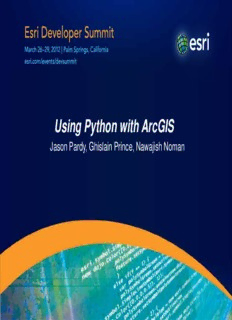
Using Python with ArcGIS - s3.amazonaws.com PDF
Preview Using Python with ArcGIS - s3.amazonaws.com
Using Python with ArcGIS Jason Pardy, Ghislain Prince, Nawajish Noman Agenda • Essentials • Creating Script tools - Why use Python scripting? • Spatial Analyst Module - What is ArcPy? • Automation - Executing tools - Messages & Error handling - Batch processing - ArcPy Classes - ArcPy Functions - Accessing Data Learning Python Scripting with ArcGIS • Python Resource Center - http://resourcesbeta.esri.com/en/communities/python/ • Desktop Help • Have a good Python Reference - "Learning Python" by Mark Lutz - published by O’Reilly & Associates - "Core Python" by Wesley J. Chun - published by Prentice-Hall Esri Training for Python http://www.esri.com/training • Instructor-Led Course • Web Course • http://training.esri.com/gateway/index.cfm?fa=search .results&searchterm=Python Python IDEs - Review of IDEs: - http://blogs.esri.com/Dev/blogs/geoprocessing/archive/2010 /09/14/Review-of-IDEs-for-Python.aspx Why Python? • Fulfills the needs of our user community - Simple and easy to learn - Scalable - Modular - Object oriented - Easy to maintain - Cross platform - Established and active user community A brief history of Python in ArcGIS • dispatch–based Geoprocessor • Python 2.1 • arcgisscripting module • Cross-platform • Python 2.4 • arcgisscripting module, 9.3 version • "Pythonic" • Python 2.5 • ArcPy site-package • data access module • Mapping support • Python toolboxes • Map Algebra support • Python add-ins • Python window • improved na module • Python 2.6 • Python 2.7 • more mapping functionality What is ArcPy? • ArcPy is a native Python site-package • Increases productivity with a richer and more native Python Experience • Includes code completion and intellisense • Includes modules covering other areas of ArcGIS: - Data access - Mapping - Extensions – Spatial Analyst (map algebra) - Network analyst - Time • Includes classes and functions making it easier to create objects such as spatial references, geometries, etc. Geoprocessing Tools • Tools are the fundamental unit of geoprocessing • There are hundreds of tools at your disposal - You can create your own tools (ModelBuilder, Python, etc.) • Any tool, once created, can be called in Python by using the arcpy.ImportToolbox function - Creates tool wrappers for your toolbox Tool Messages • Executing a tool will produce 3 types of messages. - Informative messages (severity = 0) - Warning messages (severity = 1) - Error messages (severity = 2) # start try block try: arcpy.analysis.Buffer("c:/ws/roads.shp", "c:/outws/roads10.shp", 100) # If an error occurs when running a tool, print the tool messages except arcpy.ExecuteError: print arcpy.GetMessages(2) # Any other error except Exception as e: print e.message
Description: